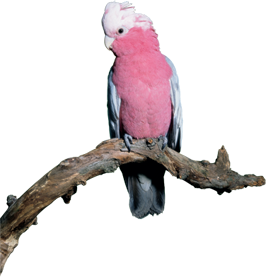Profiles
GALAH
(Cacutuaroseicapilla)
Family: Parrot
Origin: A commonly seen bird that is widely distributed throughout Australia.
Size: The overall length of this bird is 360mm, including its 150mm tail.
Description:
The male’s head, nape and under parts are pink, ranging from a dull pink on the crown to a deep, rich pink on the chest. Its back, tail and wings are light grey; its beak is a creamy colour, legs and feet are grey. Brown eyes add a dash of sparkle to all this pink.
The hens are almost identical to the males except that they have pink eyes; while the chicks in their first year of life are less pink than the adults.
Care:
In the wild these birds thrive in hollow limbs or holes of trees high up above the ground and lined with green, leafy twigs.
Even if you are only planning to keep a single bird you will still need to provide it with a decent sized cage to allow it to freely move about. Give it at least two good perches made of wood from edible trees.
And a wider rather than a taller cage is better because birds fly from side to side, not up and down.
If possible, the bird should be taken out of its cage each day and allowed to fly around the house for exercise.
If it is able to fly around the home make sure that all the windows are closed, curtains drawn (so it doesn’t crash into glass), no stoves are turned on or hot saucepans on the stove or benchtop (but ideally for safety reasons it’s best not to let the bird into kitchen), and if it can fly into the bathroom the bath should be empty and the toilet seats should be down.
Fresh seed and drinking must be supplied each day, and their seed and water dishes need to be kept clean. Stainless steel dishes are best.
You should also place fresh water into the aviary daily along with fresh greens and be sure to remove any old food and seed husks.
Seed dishes and drink vessels must be cleaned regularly. Only mild soaps should be used and then it must be rinsed off thoroughly. Never use any cleaning detergents or chemicals because birds have very sensitive systems.
Eats:
A good quality small parrot mix is best, along with seeding grasses and fruit and vegetables. Do not feed avocado as it is poisonous to birds. Cuttlefish bone, shell grit and calcium and iodine blocks needs to be available at all times too.
Features:
The hen lays from two to six eggs and both the parents incubate the developing chicks. Galahs do not breed until they are three or four years old and when they do its mostly from August to November.
Call:
It possesses a number of calls ranging from single note contact calls to harsh screeching territorial calls.
Personality:
In the wild they separate into pairs that often become permanent matings that then return to the same nest year after year.
